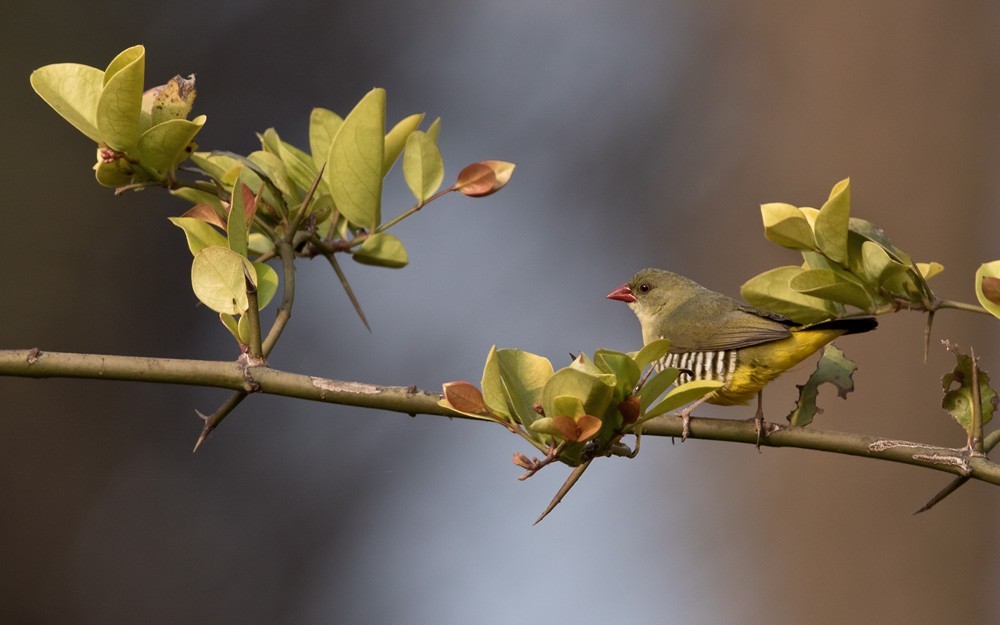Green Avadavat
A species of Avadavats Scientific name : Amandava formosa Genus : Avadavats
Green Avadavat, A species of Avadavats
Botanical name: Amandava formosa
Genus: Avadavats
Content
Description General Info
 Photo By Lars Petersson
Photo By Lars Petersson Description
The green avadavat is approximately 10 cm long with green above, yellow below, black and white bars on the flank and reddish bill. Both sexes have pale tips to wing-coverts and tertials. The upper plumage is olive green. The upper tail coverts are more yellow and the tail is black and rounded with broad feathers. The chin is pale yellow and the lower breast, belly and vent are brighter yellow. The flanks are barred with brown and white. The bill is waxy red and the legs are pale fleshy or brown. The female is slightly paler than the male. Young birds are duller with a black bill and lack the barring on the flanks. 
Size
10 cm
Nest Placement
Shrub
Feeding Habits
Green Avadavat consumes small grass seeds and insects, foraging primarily on the ground. Green Avadavat is gregarious, feeding in flocks outside of breeding season, occasionally mixing with Amandava amandava.
Habitat
Green Avadavat's typical habitats include open dry woodlands and grassy areas with tall grasses and low bushes. The species is also found in cultivated landscapes such as sugar-cane fields and mango orchards, as well as Lantana scrubs and boulder-strewn scrub areas, usually in proximity to water sources.
Dite type
Granivorous
General Info
Feeding Habits
Bird food type
Behavior
They breed in central India from October to January but are also known to breed in July. The nest is made out of broad leaves of grass or sugarcane and is spherical with an entrance on the side. The adaptability for altered habitats is a positive side of its natural survival. Several nests may be built in the vicinity by pairs that form a loose colony. They forage in small groups especially in the non-breeding season. The clutch is four to six eggs. Its voice song is high-pitched warble, ending with prolonged trill with weak seee and swee notes not unlike that of Turdoides subrufus. 
Distribution Area
This species is found mainly in the dry scrub regions and agricultural lands and is often found close to water. The largest populations are in central and north-western India. A population of escaped birds once existed near Lahore. The key areas where they are well known are in central India, around southern Rajasthan specifically around Oriya village, central Uttar Pradesh, southern Bihar and West Bengal extending south to southern Maharashtra and northern Andhra Pradesh. Some records are from further south from Wynaad in northern Kerala but it is unclear if these are wild populations. 
Species Status
The green avadavat has been a popular cage bird and has been in the bird trade since the late 19th century. It continues to be common in wild areas such as Oriya village, Achalgarh and Guru Shikhar in Mount Abu, Rajasthan, but has declined due mainly to trapping. In trade the bird is called the green waxbill. Entire flocks are easily trapped using bait and decoy birds. The mass awareness and mobilization towards protection of the habitats at Abu Hills resulted into the positive side. The awareness level could be well established by the fact that the local administration has used the bird as the Mascot (District Level) for the Indian Parliamentary Election 2019. Similarly, the lost population of Udaipur was also revived to certain extent due to efforts of Department of Forests. However, a study currently being carried out has identified habitat loss as a major threat to the birds, while pointing to a lack of awareness and concrete action to conserve the species among the local community. 

 Photo By Lars Petersson
Photo By Lars Petersson Scientific Classification
Phylum
Chordates Class
Birds Order
Perching birds Family
Estrildid finches Genus
Avadavats Species
Green Avadavat